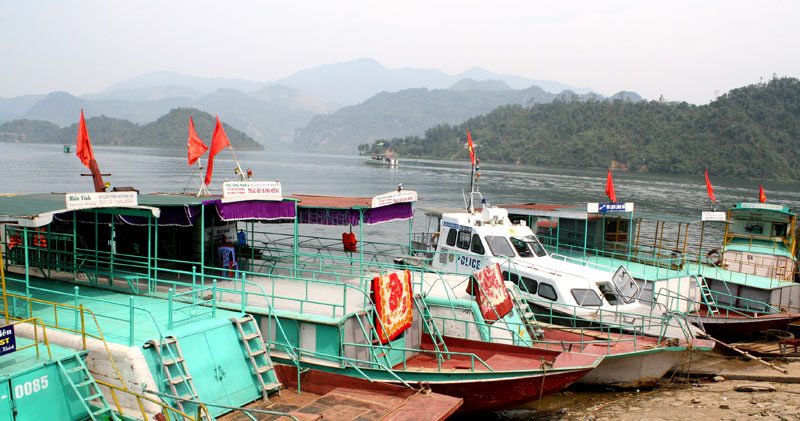
(HBO) – The waterway route on Hoa Binh Lake is 203km long and a national inland waterway route. After the man-made lake was designated as a national tourist site, the number of visitors to the lake has risen remarkably, stimulating waterway transport activities on the lake.
Thung Nai wharf in Cao Phong districts now
serves 169 operating vehicles.
Statistics from the provincial Department of
Transport showed that at the beginning of 2017, Hoa Binh lake recorded 239
passenger vehicles, of which 33 ones carrying both cargo and passengers, 115
have been registered and 124 have not. At present, 38 vessels have valid
registration while those of 77 others have expired. Waterway vehicles
registration has met a lot of difficulties, such as the lack of boat design
before building, as most local vessels were built in the traditional way
without any technical design. As the demand for tourist transportation has
surged in recent years, many households bought cargo ships and converted them
into passenger boats. Some boat owners fail to comply with regulations on
vessel registration due to poor understanding of legal regulations on waterway
transport. The use of substandard vessels for the transport of tourists poses a
high risk of accidents and violates the law.
Recently, the provincial Transport Department
partnered with relevant units to raise public awareness of abiding by legal
regulations on waterway transport safety. It also held dialogues with vessel
groups operating in Thung Nai wharf where there is a large number of vessels
engaging in water transport on Hoa Binh Lake.
The department took note of suggestions made by
vessel owners and proposed solutions to encourage vessel owners to comply with
legal regulations on inland waterway traffic safety. Via communication
activities, heads of vessel groups and boat owners became aware of
responsibility of individuals and organisations, and pledged to urge vessel
owners to promptly complete boat registration as regulated.
About the proposed special mechanism on vehicle
registration on lakes, the department will report it to the Transport Ministry
for consideration. While pending conclusion, vessel owners and register
agencies must seriously abide by the law.
The emulation movement "Hoa Binh joining hands to build new-style rural areas” has been widely spreading, becoming a driving force that motivates the localities to renew rural landscapes and improve the material and spiritual lives of the residents. In this movement, the people play a central role-both as the main implementers and direct beneficiaries of its outcomes.
In response to the global digital revolution, Hoa Binh Newspaper is transforming itself into a modern and multi-platform media hub, blending cutting-edge technology with a restructured newsroom and a new generation of tech-savvy journalists.
Hoa Binh province’s Association of the Elderly recently held a conference to review the project on expanding the inter-generation self-help club model until 2025.
In a move to implement Resolution No. 57-NQ/TW, issued on December 22, 2024 by the Politburo, which targets breakthroughs in science-technology development, innovation, and digital transformation, the Hoa Binh provincial Department of Health has issued a plan to roll out the "Digital Literacy for All” campaign within the local health sector.
An Nghia Commune (Lạc Sơn District) is one of the communes that achieved the tha standard of the national new rural area in 2018. Entering a new development phase, the commune is now trying to meet the criteria for the advanced new rural development. With the strong political will and the public consensus, the commune is gradually overcoming the challenges to reach this goal, aiming for the sustainable development.



